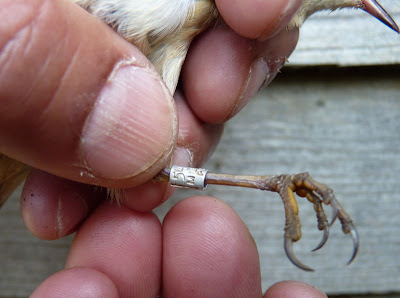Ringing generates information on the survival, productivity and movements of birds, helping us to understand why populations are changing.
The British and Irish Ringing Scheme is organised by the BTO. Over 900,000 birds are ringed in Britain and Ireland each year by over 2,600 trained ringers, most of whom are volunteers. You can help by reporting any ringed bird you find. The annual report on bird ringing is published in the Ringing Scheme journal Ringing & Migration.
Ringing birds is essential if we are to learn about how long they live and when and where they move, questions that are vital for bird conservation. Placing a lightweight, uniquely numbered, metal ring around a bird’s leg provides a reliable and harmless method of identifying birds as individuals.
 |
| Ringing a male Wigeon - Seaton Marshes Dec '07 (c) Steve Waite |
Ringing birds is essential if we are to learn about how long they live and when and where they move, questions that are vital for bird conservation. Placing a lightweight, uniquely numbered, metal ring around a bird’s leg provides a reliable and harmless method of identifying birds as individuals.
 |
| A ringed Reed Warbler - Colyford Common May '10 (c) Steve Waite |
Although we have been ringing birds in Britain and Ireland for over 100 years, we are still discovering new facts about migration routes and wintering areas. However, the main focus of the Ringing Scheme today is monitoring bird populations. Ringing allows us to study how many young birds leave the nest and survive to become adults, as well as how many adults survive the stresses of breeding, migration and severe weather. Changes in survival rates and other aspects of birds’ biology help us to understand the causes of population declines.